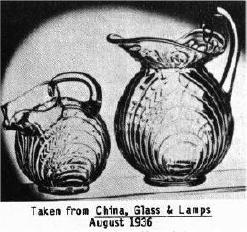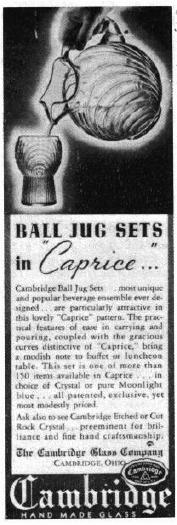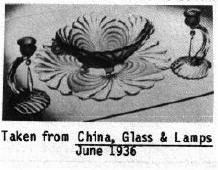Transparent Colors, Part VIII
by Mark A. Nye
Issue No. 195 - July 1989
Sometime during the first half of 1936, Cambridge brought out a new light blue color and named it Moonlight. Quoting from the N.C.C. book Colors in Cambridge Glass:
"Moonlight is a light transparent blue that is slightly deeper in color than Willow (Eleanor) Blue. Moonlight tends to collect in the heavier portions of the glass and, in patterns such as Caprice, this will cause the color to appear darker or lighter depending upon the thickness of the pattern area being viewed."
 Moonlight was used primarily in the production of the Caprice and
Gyro Optic lines. The first known trade journal mention of this color
is in an advertisement for the Caprice line, where it was listed as
"Moonlight (light blue)."
Moonlight was used primarily in the production of the Caprice and
Gyro Optic lines. The first known trade journal mention of this color
is in an advertisement for the Caprice line, where it was listed as
"Moonlight (light blue)."
"The two glass jugs illustrated show two items feature by the Cambridge Glass Co. from their Caprice line. The larger jug, which is of a Doulton type, is most attractive, while the small one, 32 oz. in size is suitable for tomato, orange or grape juice, etc. These are to be had in an etched crystal decoration or in Moonlight (light blue)."
The advertisement for Crystal Ball Jug Sets (below, right) was published in the October 1937 issue of The American Home. Note where it reads in part:
"This set is one of the more than 150 items available in Caprice - in choice of Crystal or pure - Moonlight Blue - all patented, exclusive, yet most modestly prices."
 The March 1938 issue of House and Garden carried an
advertisement for Caprice, describing it as "Most popular of American
inspirations" and stating "more than 150 items, each available in
Moonlight blue or La Rosa pink, as well as crystal." Again, quoting
from Colors in Cambridge Glass:
The March 1938 issue of House and Garden carried an
advertisement for Caprice, describing it as "Most popular of American
inspirations" and stating "more than 150 items, each available in
Moonlight blue or La Rosa pink, as well as crystal." Again, quoting
from Colors in Cambridge Glass:
"LaRosa is a medium to light pink that shows gathering tendencies. In thick areas of the item the color is very strong, while in the thin areas it is very weak and transparent. There is a suggestion of orange tone when viewing into the edge of the blank."
After the initial advertisement, the name of this new pink was spelled as one word, not two.
Two other new colors were also brought out in the early months of 1938, Mocha and Pistachio. As described in Colors in Cambridge Glass, Mocha "is a soft shade of amber that is lighter than the Amber of the late 1920s. Due to bunching or gathering effect, thicker areas of the blanks will appear to be much deeper in color. This color is easily confused with Madeira."
From the same source comes this description of Pistachio.
"It (Pistachio) is the lightest shade of all the Cambridge greens. Although lighter in tone than light Emerald, it has more of a gathering property. It will appear to have more color in the thick areas of the blank than in thin areas. It is a color with much sparkle and shows to advantage in a pattern such as Caprice."
Similar to Moonlight, LaRosa, Mocha and Pistachio were used primarily in conjunction with the Caprice and Gyro Optic patterns. Other uses included the production of Varitone and Harlequin sets. The somewhat restricted use of these colors in an aid to their identification; as the similar colors, Madeira, Emerald (light), Dianthus and Willow or Eleanor Blue were not used for these items.
The following text is from a letter dated January 6, 1937, and sent to all Cambridge sales agents. It is presented here, since it contains a reference to Moonlight.
"We have sent you sample in Moonlight of our #1492 8½" Swan with cover. It has been suggested that the Swan with cover would make and excellent Candy Box or Bon Bon, so we have changed the design of the Swan and have made the cover for it. This will be made in Crystal and Moonlight and the price is $30.00 per dozen list, subject to regular discounts."
In another such letter, this one dated June 1939, The Cambridge Glass Company, through its Sales Manager, W.C. McCartney, informed its agents of a somewhat unique item being offered as a result of customer demand.
"We are having calls again from a great many of our customers and representatives for the #3011/9 Cocktail made with Crown Tuscan Stem and Foot and a colored Bowl. The colored bowl that seems to be in demand is the Gold Krystol. We have made up a few orders of these for several of our customers and think it advisable to send you a sample of the item, which is going forward to you with other samples. We are only going to make it one way. Crown Tuscan Stem and Foot with Gold Krystol Bowl and the list price of it will be $15.00 per dozen. If you specialize on this item for Holiday trade, we believe you will be able to send us some nice orders."
 Although color remained very much a part of the Cambridge line
during the second half of the 1930s, very little mention of it is found
in advertising dating to those years. Caprice advertisements continued
to refer to Moonlight and LaRosa, but the other remaining Cambridge
colors are seldom mentioned. As the 1930s drew to a close, price lists
dating to the last months of 1939 indicated transparent colors in the
Cambridge line consisted of Amber, Emerald (light), Dianthus Pink,
Moonlight, Forest Green, Royal Blue, Amethyst, Carmen and to a very
limited extent, Gold Krystol.
Although color remained very much a part of the Cambridge line
during the second half of the 1930s, very little mention of it is found
in advertising dating to those years. Caprice advertisements continued
to refer to Moonlight and LaRosa, but the other remaining Cambridge
colors are seldom mentioned. As the 1930s drew to a close, price lists
dating to the last months of 1939 indicated transparent colors in the
Cambridge line consisted of Amber, Emerald (light), Dianthus Pink,
Moonlight, Forest Green, Royal Blue, Amethyst, Carmen and to a very
limited extent, Gold Krystol.
Use of these colors continued until the fall of 1943 when a letter from Mr. McCartney, dated October 16, went out to all Cambridge customers. In part this letter read:
"Much to our regret, due to the labor and material situation, over which we have no control, it has become necessary for us to discontinue the manufacture of many of our colors. From this date on we will be unable to produce any further supply of the Harlequin or Rainbow sets, for which no doubt you have orders with us. We are cancelling all of the orders for delivery either this year or next, as of this date. We will still continue to make the Crown Tuscan, Moonlight, Amethyst and the Amber colors. So items that you have had in the past in these colors you can still continue to order in 1944"
